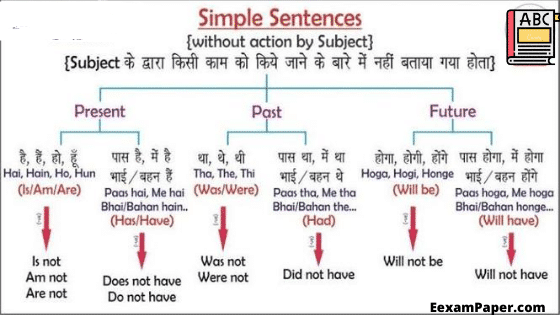यहाँ पर हमको आज English के Tense के बारे में आपको Tense in Hindi to english में बताएंगे।
अंग्रेजी को एक अंतरराष्ट्रीय भाषा के रूप में जाना जाता है। इसलिए इसे बोलना, पढ़ना, समझना बहुत ही जरूरी हैं। हमारे बहुत से हिंदी भाषी विद्यार्थियों के लिये English language को समझना बहुत ही कठिन कार्य हो जाता है।
इन्हीं बातों को ध्यान में रखते हुये EexamPaper.com आप सभी हिंदी भाषा मे अध्ययन करने वाले विद्यार्थियों के लिए Tense Rules को हिंदी में लेकर आये हुए हैं। इस पोस्ट Tense in Hindi में आप सभी को Tense से संबंधित सभी जानकारी उपलब्ध कराएंगे और Tense Rule in Hindi की Exercise और Example की सहायता से Tense की परिभाषा भी बताएंगे।

What is Tense in Hindi?
Tense जिसका हिन्दी में शाब्दिक अर्थ होता है – “काल” । इससे किसी भी कार्य के होने का समय पता चलता है कि किया गया कार्य भूतकाल (Past Tense), भविष्य काल (Future Tense), या वर्तमान काल (Present Tense) में है।
Tense की परिभाषा हिंदी में।
जिसके माध्यम से किसी भी किए कार्य के होने के समय का बोध होता हैं। उसे काल (Tense) कहते हैं।
Tense के प्रकार हिंदी में।
Tense तीन प्रकार के होते हैं जोकि निम्नलिखित हैं –
01. # Present Tense
02. # Past Tense
03. # Future Tense
Tense Chart in Hindi में समझें

Tense (काल)
हमने अभी आपको ऊपर Tense की परिभाषा और Tense के कितने प्रकार होते हैं यह बताया है।
जिस प्रकार समय को तीन भागों में बांटा गया वर्तमान, भूत और भविष्य इसी प्रकार Tense को भी तीन भागों में बांट दिया गया है :- वर्तमान काल, भूतकाल और भविष्य काल अब आगे हम अपने इस पोस्ट के माध्यम से Tense के तीनों प्रकार के बारे में विस्तार से बताएंगे। आपको अधिक समझ में आ जाए इसलिए हमने Tense with Example का भी प्रयोग किया है।
Tense के तीन प्रकार होते है।
- Present Tense (वर्तमान काल)
- Past Tense (भूत काल)
- Future Tense (भविष्य काल)
प्रत्येक Tense के चार प्रकार होते है।
- Indefinite या Simple
- Continuous या Imperfect या Progressive
- Perfect
- Perfect Continuous
इस प्रकार Present Tense, Past Tense और Future Tense के कुल चार – चार प्रकार भेद हुए। अतः अब कुल मिलाकर Tense की संख्या बारह (Twelve, 12) हो गई है। अब इन बारह Tense का अलग-अलग विस्तृत रूप से उनके प्रयोग को Active Voice में करना Example सहित Tense को हिंदी में सीखेंगे।
Present Tense in Hindi (वर्तमान काल)
Present Tense किसी भी कार्य को यह बताता है कि दिया गया या किया गया कार्य वर्तमान समय (Present Time) में हैं।
Present Tense के प्रकार
Present Tense के कुल 04 प्रकार के होते हैं।
- Present Indefinite या Simple Present Tense
- Present Imperfect या Continuous या Progressive Tense
- Present Perfect Tense
- Present Perfect Continuous Tense
अब हम Present Tense के चारों प्रकार के बारे में अलग-अलग जानेंगे और इसके Hindi to English Translation के Rules को भी समझेंगे।
Simple Present या Present Indefinite Tense in Hindi
Present Indefinite Tense की पहचान :- जिस वाक्य (Sentence) की मूल क्रिया के अंत में ता हैं / ती हैं / ते हैं / ता हूँ / ती हूँ इत्यादि लगा रहे, तो ऐसी क्रिया का अनुवाद Present Indefinite Tense में किया जाता है।
Hindi से English में अनुवाद के नियम | Hindi से English में Translation Rules
Structure :- Sub + V1 + s/es + object.
- STEP 01 # सबसे पहले Subject, उसके बाद क्रिया (Verb) तथा Subejct के Person तथा Number के अनुसार क्रिया में s / es का प्रयोग किया जाता है।।
- STEP 01 # S और ES का प्रयोग : Third Person Singular Number के Subject के साथ क्रिया में s / es को
Hindi to English Translation
-
Affirmative Sentences
Sub + V1 + s/es + Other Words.
-
Interrogative Sentences
Do / Does + Sub + V1 + Other Words.
-
Negative Sentences
Sub + Do / Does + Negative word +V1 + Other Words.
-
Negative Interrogative Sentences
Do / Does + Subject + Negative word +V1 + Other Words.
or
Don’t / Doesn’t + S + V1 + Other Words.
Simple Present या Present Indefinite Tense Examples in Hindi
| Affirmative Sentences | राम रोटी खाता हैं। | Ram eates bread. |
| Interrogative Sentences | क्या तुम अंग्रेजी पढ़ते हो ? | Do you read English ? |
| Negative Sentences | मैं चावल नहीं खाता हूं । | I do not eat rice. |
| Negative Interrogative Sentences | क्या मैं अंग्रेजी नहीं जानता हूं ? | Do I not know English? |
Present Tense / Simple Present Tense को विस्तार से पढ़ने के लिए यहां क्लिक करें।
Present Imperfect या Continuous Tense in Hindi
Present Continuous Tense की पहचान :- जिस वाक्य (Sentence) की मूल क्रिया के अंत में रही हैं / रहा हैं / रहे हैं / रही हूँ / रहा हूँ इत्यादि लगा रहे, तो ऐसी क्रिया का अनुवाद Present Continuous Tense में किया जाता है।
Hindi से English में अनुवाद के नियम :-
Structure :- Sub + Is /Am / Are + V1 + Ing + Other words.
- सबसे पहले Subject, उसके बाद Subejct के Person तथा Number के अनुसार Is/Am/Are का प्रयोग किया जाता है।
- इसके पश्चात मुख्य क्रिया में ‘ing’ को जोड़कर Is/Am/Are के बाद रखा जाता है तथा अंत में अन्य पद जैसे Object आदि को रखा जाता है।
- Is, Am, Are का प्रयोग : Third Person Singular Numberके Subject के साथ Is, First Person Singular Number के Subject के साथ Am तथा We, You, They, या अन्य किसी Plural Number के Subject के साथ Are का प्रयोग किया जाता है।
Present Imperfect / Continuous Tense Examples in Hindi
| Affirmative Sentences | राम रोटी खा रहा हैं। | Ram is eating bread. |
| Interrogative Sentences | क्या तुम अंग्रेजी पढ़ रहे हो ? | Are you reading English ? |
| Negative Sentences | मैं चावल नहीं खा रहा हूं । | I am not eating rice. |
| Negative Interrogative Sentences | क्या मैं अंग्रेजी नहीं जान रहा हूं ? | Am I not knowing English? |
Present Imperfect Tense / Present Continuous Tense को विस्तार से पढ़ने के लिए यहां क्लिक करें।
Present Perfect Tense in Hindi
Present Perfect Tense की पहचान :- जिस वाक्य (Sentence) की मूल क्रिया के अंत में चुका हैं / चुकी हैं / चुके हैं / चुके हो इत्यादि अथवा या हूँ / यी हूँ / ये हैं / ये हो / या है / ई हैं लगा रहे, तो ऐसी क्रिया का अनुवाद Present Perfect Tense में किया जाता है।
Hindi से English में अनुवाद के नियम :-
Structure :- Sub + Has / Have + V3 + Other words.
Present Perfect Tense Examples in Hindi
| Affirmative Sentences | राम रोटी खा चुका हैं। | Ram has eaten bread. |
| Interrogative Sentences | क्या तुम अंग्रेजी पढ़ी हो ? | Have you read English ? |
| Negative Sentences | मैंने चावल नहीं खाया हूं । | I have not eaten rice. |
| Negative Interrogative Sentences | क्या मैं अंग्रेजी नहीं जान चुका हूं ? | Have I not known English? |
Present Perfect Tense को विस्तार से पढ़ने के लिए यहां क्लिक करें।
Present Perfect Continuous Tense in Hindi
Present Continuous Tense की पहचान :- जिस वाक्य (Sentence) की मूल क्रिया के अंत में ता रही हैं / ता रहा हैं / ता रहे हैं / ती रही हूँ / ता रहा हूँ इत्यादि लगा रहे, तो ऐसी क्रिया का अनुवाद Present Perfect Continuous Tense में किया जाता है।
Hindi से English में अनुवाद के नियम :-
Structure :- Sub + Has been / Have been+ V1+ Ing + Other words.
Present Perfect Tense Examples in Hindi
| Affirmative Sentences | राम रोटी खाता रहा हैं। | Ram has been eating bread. |
| Interrogative Sentences | क्या तुम अंग्रेजी पढ़ती रही हो ? | Have you been reading English ? |
| Negative Sentences | मैंने चावल नहीं खाता रहा हूं । | I have been not eating rice. |
| Negative Interrogative Sentences | क्या मैं अंग्रेजी नहीं जानता रहा हूं ? | Have I been not knowing English? |
Present Perfect Continuous Tense को विस्तार से पढ़ने के लिए यहां क्लिक करें।
दोस्तों आप Social Media जैसे Facebook पर हमारे Latest Post के Notification पाना चाहते हैं तो आप हमारे Facebook Page को जरूर Like करें, और अगर आप Facebook पर हमारे साथ जुड़कर अपनी Knowledge और Information को Share करना चाहते हैं तो हमारे Facebook Group E Exam Paper को जरूर Join करें ।
इसी प्रकार के नोट्स, प्रतियोगी परीक्षाओं के प्रश्न पत्र , प्रतियोगी परीक्षाओं से जुड़ी महत्वपूर्ण जानकारी के लिए हमारे टेलीग्राम चैनल (Telegram Channel) से जुड़े जहाँ पर सभी प्रकार के नोट्स, पेपर आदि के पीडीएफ (PDF) साझा किया करते है।
निवेदन – अगर आपके पास किसी भी प्रतियोगी परीक्षा के प्रश्नपत्र है तो कृपया आप ([email protected]) दिए गए ई-मेल पते पर भेजने की कृपा करे जिससे आपके जैसे अन्य प्रतियोगी छात्रों को आगामी परीक्षाओं में ये प्रश्न पत्र महत्वपूर्ण साबित होंगे।
nice
शुक्रिया !
Very informative article sir. You have explained everything about tense.
Ji, Thank You